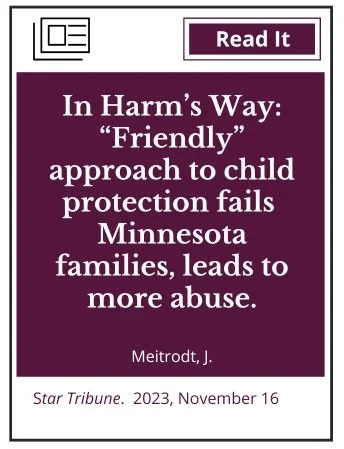Dr. Rycus Provides DR Information that Informs News Series
The Star Tribune’s year-long investigation revealed deep failures in Minnesota’s child protection system, where judges frequently returned children to unsafe homes despite evidence of abuse or neglect—sometimes with fatal results. Over the past decade, at least 15 children died from maltreatment or suicide after reunification, and hundreds more suffered renewed abuse.
The investigation highlights cases like 6-year-old Eli Hart, murdered by his mother just days after regaining custody, and 9-year-old Heaven Watkins, beaten to death despite warnings from relatives. State law prioritizes reunification “at the earliest possible time,” but this has led to returns even when parents failed therapy, drug tests, or engaged in new criminal behavior. In 18 fatal cases, reunifications occurred despite explicit warnings from social workers or family.
Federal records show 552 Minnesota children were abused again in 2021 after being sent back to their caregivers—up 60% from 2014—with nearly 13% removed a second time, well above federal safety standards. Minnesota also has one of the nation’s highest failed reunification rates, repeatedly missing benchmarks without facing state penalties.
Critics, including former Chief Justice Kathleen Blatz and child welfare experts, say the system prioritizes parents’ rights over child safety. Advocates argue that overburdened caseworkers, high caseloads, and inadequate funding prevent proper oversight. Recommendations from a 2015 state task force—like caseload limits and increased funding—were never fully implemented.
The state Department of Human Services monitors county compliance but rarely imposes sanctions, preferring “collaboration.” Mortality reviews, intended to identify systemic failings after child deaths, are inconsistently conducted and have led to no significant policy changes in recent years.
Several tragic examples show the risks of premature reunification: infants dying from abuse or overdose, children enduring years of sexual assault, and parents with histories of homicide or severe abuse regaining custody.
While some officials insist Minnesota strikes the right balance between child safety and family preservation, others warn the pendulum has swung too far toward reunification at any cost. Experts stress that a single death signals far wider systemic risks, with many more children left in dangerous environments. The report concludes that without stronger safeguards, better screening, and more resources, Minnesota will continue to return vulnerable children to harm.
Read the articles in the series to find out more.



